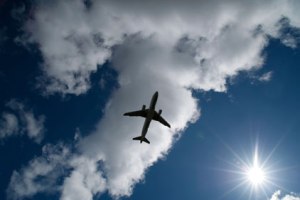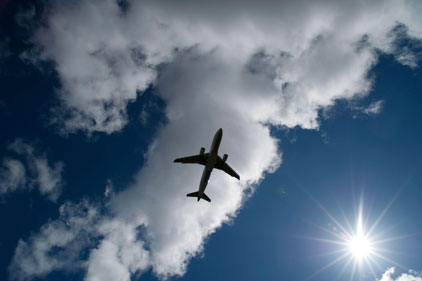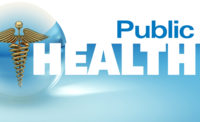 On October 2, 2014, the Centers for Disease Control and Prevention (CDC) issued guidelines to airlines on stopping ill travelers from boarding, managing and reporting onboard sick travelers, protecting crew and passengers from infection, and cleaning the plane and disinfecting contaminated areas.
On October 2, 2014, the Centers for Disease Control and Prevention (CDC) issued guidelines to airlines on stopping ill travelers from boarding, managing and reporting onboard sick travelers, protecting crew and passengers from infection, and cleaning the plane and disinfecting contaminated areas.
Key Points
A U.S. Department of Transportation rule permits airlines to deny boarding to air travelers with serious contagious diseases that could spread during flight, including travelers with possible Ebola symptoms. This rule applies to all flights of U.S. airlines, and to direct flights (no change of planes) to or from the United States by foreign airlines.
Cabin crew should follow routine infection control precautions(http://www.cdc.gov/quarantine/air/managing-sick-travelers/commercial-aircraft/infection-control-cabin-crew.html) for onboard sick travelers. If in-flight cleaning is needed, cabin crew should follow routine airline procedures using personal protective equipment available in the Universal Precautions Kit. If a traveler is confirmed to have had infectious Ebola on a flight, CDC will conduct an investigation to assess risk and inform passengers and crew of possible exposure.
Hand hygiene and other routine infection control measures should be followed.
Treat all body fluids as though they are infectious.
Follow these routine precautions:
- Keep the sick person separated from others as much as possible.
- Wear waterproof disposable gloves before directly touching the sick person, blood, or other body fluids.
- When providing direct care to a sick traveler who came from a country with an Ebola outbreak, also wear surgical mask (to protect from splashes or sprays), face shield or goggles, and protective apron or gown (see below: Universal Precaution Kit).
- Do NOT give a surgical mask for someone who is nauseated or vomiting. Wearing a mask could harm a traveler who is vomiting. Give an air sickness bag if traveler is vomiting or reports feeling nauseated.
- Give a plastic bag for disposing used tissues or soiled air sickness bag.
- Give a surgical mask if a sick traveler is coughing or sneezing, if the sick person can tolerate wearing one. If a mask cannot be tolerated, provide tissues and ask the person to cover mouth and nose when coughing or sneezing.
- Notify cleaning crew: Cabin crew should notify the airline's ground and cleaning crews about any ill traveler on board an aircraft so that preparations can be made to clean the aircraft after passengers have disembarked.
- Universal Precaution Kits: Airplanes traveling to countries affected with Ebola should carry Universal Precaution Kits, as recommended by the International Civil Aviation Organization (ICAO), for managing ill travelers.
Guidance for airline cleaning personnel
Ebola spreads through direct contact by touching the blood or other body fluids (like feces, saliva, urine, vomit, and semen) of a person who is sick with Ebola. Infected blood or other body fluids can spread Ebola through breaks in your skin or if they get into your eyes, nose, or mouth.
Treat any body fluid as though it is infectious. Hand hygiene is the most important infection control measure.
When cleaning aircraft and any contaminated areas after a flight with a sick traveler who may have Ebola, CDC recommends that personnel:
Use disposable protective equipment while cleaning the passenger cabin and lavatories. If working with reusable equipment, properly clean and disinfect it after use.
Waterproof gloves
- Change gloves if they become dirty or damaged during cleaning.
- Consider double-gloving if cleaning large amounts of blood or other body fluids.
- Throw away used gloves according to your company's recommended infection control precautions.
- Clean hands with soap and water immediately after gloves are removed or when changing gloves. (When soap is not available, use waterless alcohol-based hand sanitizer with at least 60% alcohol.) Use only soap and water if hands are visibly dirty.
Surgical mask
Eye protection: goggles or face shield
Long-sleeved, waterproof gown
Closed-toe shoes and shoe covers. If increased risk of splashing or area appears highly contaminated with body fluids, wear rubber boots or shoe covers. Wear gloves to carefully remove shoe covers to avoid contamination of hands.
Safe removal and hygiene
- Carefully remove protective equipment to avoid contaminating yourself or your clothes.
- After removing protective equipment, clean your hands. Use only soap and water if hands are visibly dirty.
- Clean affected areas
- Use an Environmental Protection Agency (EPA)-registered cleaner/disinfectant that has been tested and approved for use by the airplane manufacturers.
- Lavatory surfaces: door handle, lock, faucet, sink, walls, counter, and toilet seat.
- Sick traveler’s seat and the seats around it, seat backs, armrests, tray tables, video monitor, light and air controls, and adjacent walls and windows
- If a seat cover or carpet is obviously dirty from blood or body fluids, it should be removed and discarded by the methods used for biohazardous material.
- If surfaces are contaminated with large amounts of body fluids (such as blood, vomit, feces), clean off the material before applying disinfectant.
Special considerations
- Special cleaning of upholstery, carpets, or storage compartments is not indicated unless they are obviously dirty from blood or other body fluids.
- Special vacuuming equipment or procedures are not necessary.
- Do NOT use compressed air, pressurized water or similar procedures, which might create droplets of infectious materials.
Guidance for air cargo personnel
Packages or luggage should not pose a risk. Ebola virus is spread through direct contact with blood or body fluids (like feces, saliva, urine, vomit, and semen) from an infected person.
Don’t handle packages visibly dirty from blood or body fluids.
Wash your hands often to prevent other infectious diseases.


